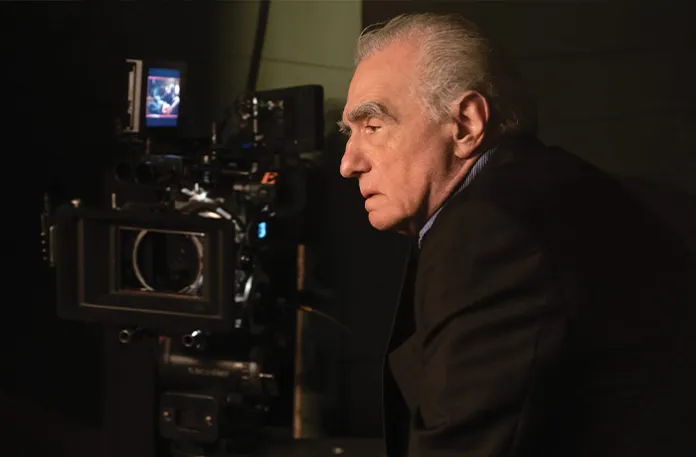The summer before I went to college, a much-admired older boy loaned me a copy of Scorsese on Scorsese, a book-length interview concerning Mean Streets, Taxi Driver, Raging Bull, and other pictures from the director’s early oeuvre. I had seen none of those movies. Yet, the volume was a revelation, not only because of its aroma of exciting adulthood but because its aesthetic principles had previously lain beyond my grasp. The house in which I had been raised was literate but not artistic. Martin Scorsese’s way of talking and thinking about his work opened a door that I badly wanted to see beyond.
Those happy weeks came back to me as I watched Mr. Scorsese, Apple TV’s masterful new docuseries of the auteur’s filmography and life. Directed by Rebecca Miller, wife of occasional Scorsese collaborator Daniel Day-Lewis, the series is a worthy summing-up of one of the great careers in cinematic history. Among those participating are Scorsese mainstays Robert De Niro and Leonardo DiCaprio, who, between them, starred in 15 of the director’s movies (and counting). Steven Spielberg provides forthright commentary, as do Brian De Palma, Spike Lee, Ari Aster, and a host of other Hollywood peers.
The picture that emerges over five episodes is of a director driven by unusual ideologies and desires. Born in 1942 to first-generation Sicilian immigrants, Scorsese lived briefly in a close-knit Queens neighborhood before an arcane disagreement forced his family to retreat to the Bowery. There, surrounded by mobsters, the future moviemaker embraced Catholicism and the Italian code of omertà. (“If you see something, don’t say anything,” Scorsese’s mother recalls advising her children.) These twin influences, religious fervor and a preoccupation with dangerous men, would go on to define the next six decades of the director’s working life, finding expression as a conviction that even scoundrels are in possession of a soul. As the auteur himself says in one of many revealing vignettes, “I think anybody’s capable of evil, given the right and wrong circumstances.”

Mr. Scorsese’s early episodes follow their subject from the streets of Little Italy to the Hollywood of the 1970s. Having already directed a well-received independent feature (Who’s That Knocking at My Door) and two critical hits (Mean Streets and Alice Doesn’t Live Here Anymore), the filmmaker soon set out to make 1976’s Taxi Driver, a picture that would secure his place among the nation’s leading cinematic artists. Dismissed as a “brutalizing experience” by Cannes jury president Tennessee Williams, the film nevertheless won the Palme d’Or, as well as adulation from American critics. Though the director’s next production, New York, New York, largely failed, 1980 saw the release of Raging Bull, named the best picture of the decade by the American Film Institute, Roger Ebert, and others.
These were, as the man himself readily admits onscreen, the auteur’s cocaine years. Among Mr. Scorsese’s many pleasures, however, is its interest in its subject’s craftsmanship, an attention to cinematic detail seemingly unhindered by struggles with addiction and poor health. With Scorsese as a guide, we grasp how the filmmaker used framing techniques to render Travis Bickle’s isolation, allowing De Niro into other actors’ shots but permitting no one else to enter his. We learn that Scorsese staged Jake LaMotta’s final bout with Sugar Ray Robinson using Psycho’s shower scene as a model. We’re shown Joe Pesci’s famous “Funny How?” scene from the 1990s Goodfellas and invited to reflect upon the fact that the sequence uses no closeups. Consequently, the creeping dismay of Henry Hill’s tablemates is at least as significant as Ray Liotta’s rising panic and fear.
Had Scorsese made only the pictures mentioned thus far, he would have gone down as an icon of the medium and a true American original. How many film directors are responsible, at second hand, for the attempted assassination of a president, as Scorsese was due to John Hinckley’s Taxi Driver-esque assault on Reagan? As moviegoers know, of course, much more lay ahead, not only a “blasphemy” feud with Catholic and Evangelical leaders following screenings of The Last Temptation of Christ (1988) but a six-picture collaboration with DiCaprio that would give the filmmaker a thrilling late-in-life boost. In Miller’s hands, Mr. Scorsese is more than an appreciation of this sterling work. It is a deep dive into why movies are important in the first place. Students of cinema — or of fin-de-millénaire Americana, for that matter — will eat it up and wish heartily for seconds.
VIBE TWEAK: REVIEW OF ‘AFTER THE HUNT’
This is not to say that Apple’s docuseries is perfect. Trailing the production like so much flotsam is a slew of psychoanalytic “insights” designed to place the director inside the minds of his protagonists. Case in point: Ex-wife Isabella Rossellini’s assessment of the auteur’s religiosity is juxtaposed with a clip of Jake LaMotta banging his head against a wall. If Freud is your copilot, you will likely greet such material with joy. I found it cloying and beside the point. Never mind the man himself, who, anyway, emerges as something of a whiner and malcontent. The work is the thing.
Is Scorsese’s work actually good, rather than merely famous? Some of it is quite bad. I defy anyone to make it through 1999’s Bringing Out the Dead without resorting to mood-altering substances. As for the rest, at this point it hardly matters. From 1976 to 1990, Martin Scorsese made films that are part of the American songbook, as quintessential in their way as “Washington Crossing the Delaware” or “The Old Rugged Cross.” Simply to read about them changed, in no small measure, the course of this critic’s education. Now, thanks to Apple’s outstanding production, many others may have a similar encounter.
Graham Hillard is editor at the James G. Martin Center for Academic Renewal and a Washington Examiner magazine contributing writer.























